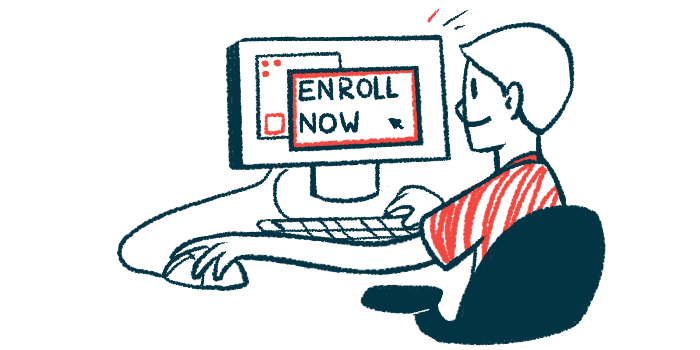Trial of Brain Computer Interface Still Recruiting ALS Patients, Others
BCI aims to transform patients' brain signals into actions

A clinical trial is evaluating whether a new, implantable brain computer interface (BCI) is able to decode brain signals — ones research has shown are related to tasks relying on the hands or speech — and transform them into actions for people with neurological disease or injury.
Up to 15 adults who are paralyzed due to neuromuscular disorders or injuries, including people with amyotrophic lateral sclerosis (ALS), will be enrolled in the study, called BrainGate2 (NCT00912041).
The trial is now recruiting patients with ALS, muscular dystrophy, spinal cord injury, stroke, or other neuromuscular conditions, at five U.S. sites. Additional trial sites may be opened in the future, researchers noted, but for now, the study centers are in Georgia, Massachusetts, and Rhode Island, as well as two cities in California.
Participants, who may be ages 18 to 75, must live within a three-hour drive of the study site, and be available for brain surgery and regular assessments. A time commitment of 13 months is required.
A BrainGate initiative
The pilot trial, initiated in 2009, is an initiative of BrainGate, a consortium of international universities and academic medical centers focused on the research, development, and testing of brain computer interface technologies. The goal of BCI is to restore the communication abilities, mobility, and independence of people with neurologic disease, injury, or limb loss.
In some of these patients, the areas of the brain responsible for certain movements and speech are intact. However, signals cannot get through to the nerves and muscles that need to receive command impulses to execute such functions.
BCI technologies commonly use machine learning to interpret intent-to-move nerve impulses from the motor cortex — a brain region responsible for voluntary movement — and transform them into specific digital actions.
Machine learning is a form of artificial intelligence that uses algorithms to analyze data, learn from its analyses, and then make a prediction about something.
Some of the consortium’s previous studies have allowed the conversion of neural signs from attempted handwriting movements into text output in a computer in real-time. They’ve also helped participants with paralysis control a robotic arm and hand.
In BrainGate 2, the goal is to obtain preliminary safety data on the investigational BrainGate BCI device — found in earlier studies to help paralyzed people type faster. This trial also will assess whether the technology allows people with paralysis, including those with severe speech impairment, to recover multiple abilities that normally rely on the hands or on speech.
Participants, who must have incomplete or complete paralysis in the arms and the legs or speaking difficulties, will undergo surgery to have Utah Arrays — tiny square grids with 100 micro-electrodes — implanted into the motor cortex and in speech-related areas.
The arrays obtain nerve cell impulses that are conveyed to one or two small metal pedestals placed on top of the head. From there, the signals can be connected to a computer, which will decode them into digital signs through sophisticated algorithms created by advanced machine-learning techniques.
The ultimate goal is to allow participants to control a computer cursor and other assistive devices, including communication software such as email, with only their thoughts.
Researchers at the trial’s University of California Davis (UC Davis) site are particularly interested in using the BCI to “read” the brain signals meant to move the muscles involved in speaking — specifically the tongue, jaw, lips, voice box, and diaphragm. The team wants to translate these signals into comprehensible speech produced by a computer.
“Losing the ability to speak is devastating,” David Brandman, MD, PhD, the trial’s principal investigator at UC Davis, said in a university press release.
“The existing assistive communication technologies available to people living with paralysis, such as eye trackers, and sip and puff devices, are slow, cumbersome, and require substantial effort from both the user and their caretaker,” Brandman said.
Brandman, who will lead the surgeries for the study, is an assistant professor in the UC Davis department of neurological surgery. He also is the co-director of the UC Davis Neuroprosthetics Lab, together with Sergey Stavisky, PhD, who is working as the scientific lead for the study and is an assistant professor in the same department.
“By implanting electrodes that can record from individual brain cells involved in generating speech, we hope we can enable the participants to communicate by just trying to speak,” Stavisky said.
Research into brain computer interface
The scientists anticipate the produced algorithms will be able to accurately decode the neural patterns into speech, which can then be paired with text-generating or synthetic speech-generating devices.
“We hope to learn what brain cells do when a person tries to speak,” Stavisky said.
“For example, what kind of information does this brain activity contain? How does that relate to the movements or sounds the person is trying to produce? With this study, we anticipate we will be able to answer those and many other questions,” Stavisky said.
The neuroscientist also emphasized that several research groups and companies are testing and improving BCIs to recover functions lost with certain neurological and neurodegenerative diseases.
Notably, clinical trial data showed that Synchron’s Stentrode, an innovative BCI that does not require surgery to be implanted, allowed four ALS patients to communicate and perform daily online tasks by using “just their thoughts.”
“Based on how this field has been progressing and the strength of our interdisciplinary research team, I am hopeful that we can quickly make substantial progress towards restoring the ability for people who have lost the ability to speak to have naturalistic, real-time conversations,” Stavisky said.
Leigh Robert Hochberg, MD, PhD, the director of the BrainGate consortium and the sponsor of the BrainGate 2 trial, said: “I’m thrilled to welcome David, Sergey and the wonderful neuroengineering community at UC Davis to the BrainGate clinical trials.”
“Their scientific and clinical insights will undoubtedly lead to breakthroughs toward the restoration of communication,” added Hochberg, a neurointensivist at Massachusetts General Hospital, one of the other sites in the BrainGate 2 trial.
He also is a faculty member at Brown University and Harvard Medical School, and the director of the Veterans Affairs (VA) Rehabilitation Research and Development Center for Neurorestoration and Neurotechnology at Providence VA Health System.
In addition to the study centers at Massachusetts General and UC Davis, patients are being enrolled at Stanford University School of Medicine, also in California, and at Emory University School of Medicine, in Georgia, and the Providence VA Medical Center, in Rhode Island.
“It’s my hope that brain-computer interface technology will one day restore functional independence for people living with paralysis,” Brandman said.








